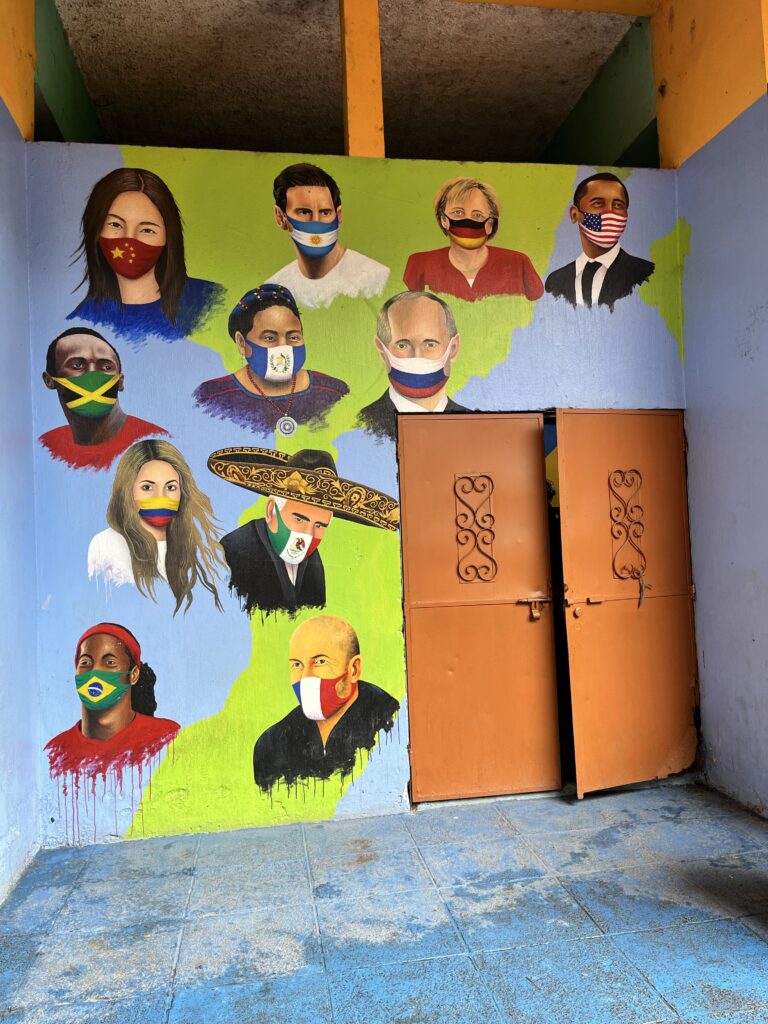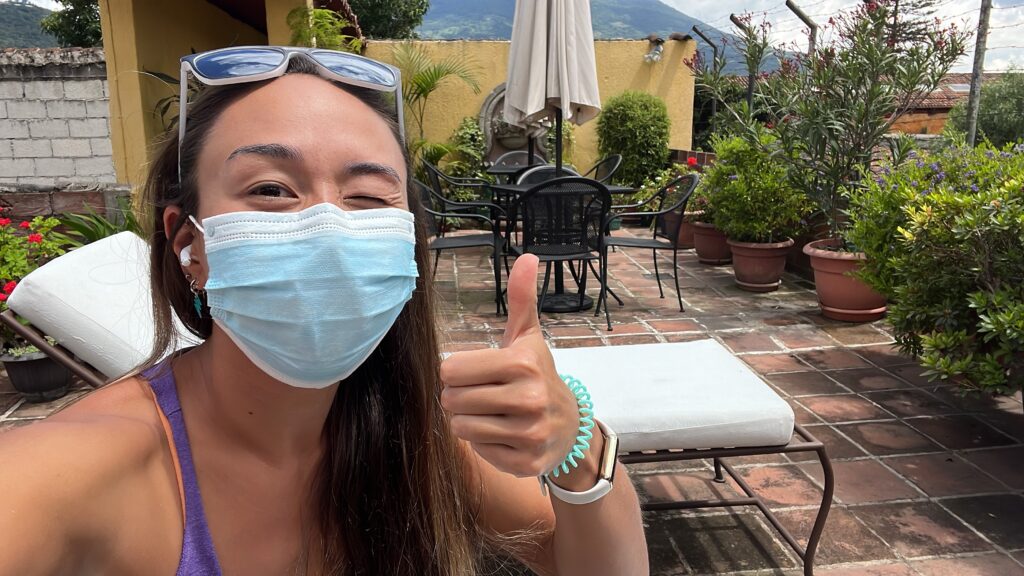As I’m writing this, it’s been two years and eight months since things got weird. It’s strange to think that we’ve been living in this post-pandemic world for so long. When I say “post-pandemic” I don’t mean that COVID is over, per se, but more that the pandemic changed things in such a way that it is necessary to talk about the world (and our lives) in terms of “before” and “after.”
In the last few years, we’ve collectively experienced a lot of grief and suffering. Even though the world is moving on, those things change you in ways that don’t just disappear with vaccinations and IRL work meetings. At the same time, the pandemic has been a catalyst for a lot of positive things. For me, that includes my decision to finally embark on long-term travel after a decade of keeping plans on the back burner. During the height of the pandemic, I spent a lot of time thinking about mortality, the fragility of life, and how quickly the rug can be pulled from beneath your feet. It prompted me to do some of the things I’ve been putting off.
Five months in, it’s clear that I’m not the only person who’s on a post-pandemic walkabout. The pent-up demand for travel is very real–as evidenced by airline prices over the summer. And of course, long-term travel is a common rite of passage–much more common for Europeans, Canadians, and Australians than Americans, it seems. Many of the other foreigners I’ve met who are doing what I’m doing are also quite a bit younger than me. In the hostel circuit, there will always be a handful of standard scripts, reasons, and life stages that account for people’s travel. I’ve met Brits taking some time to travel between “college” and “uni,” Israelis out exploring Latin America after their time in the military, and recent-grads from all over who are looking for a bit of adventure before they join the workforce. And then there is a whole category of people who, like me, have been spurred into action by the pandemic. Many who’ve been working, living their grown-up lives, and realized in the last couple of years that they need a break, or want to make a big change, so they’re out here looking for something within themselves as they explore the world.
Travel Requirements
It’s exciting to be out here, doing what I’ve aspired to for so long. It’s also strange. Not just because the experience sometimes feels a little surreal, but because the world is just different now. If, like me, you haven’t left the US since pre-COVID, there are some new things to know about the process. In terms of travel logistics, it seems like COVID will bring about a paradigm shift similar to what we saw after 9/11.
At the time that I’m writing this, many countries require either proof of vaccination or a negative COVID test for entry. But even though we’re almost three years in, things are still changing all the time. When I was about to leave for Guatemala, even vaccinated people needed a negative COVID test to enter the US, even if it was just for a connection. But a few days before I left, they dropped that requirement. I had already purchased a pack of pricey, bulky, online-proctored rapid tests to use when I flew through Miami to the Caribbean, but I left them all behind.
Additionally, most countries currently require you to fill out a digital health affidavit form that also asks some questions for contact tracing. Sometimes you need to show proof that you’ve completed the form before you board your flight. They usually want you to fill out the form within 48-72 hours of your flight, so I’ve found that it’s a good idea to just do it the day before. I’ve had a couple of times when I forgot to complete the form ahead of time, and got held up at the airline check-in desk trying to fill it out last minute. When I was leaving Chile to head to Colombia, I had no cell signal at the airport and the airport wifi wasn’t working for me. I ended up having to ask a stranger to hotspot me. Luckily I speak enough Spanish to make that request and I was there three hours early, but it was still kind of stressful.
Every Country is Different

I’ve visited eight countries in the last five months, and besides airline and immigration protocols, I’ve found that each country has a different approach to COVID in 2022. It’s been interesting to observe. The varying prevalence of mask use has been an especially visible metric. But I’ve also been talking with people I’ve met, asking them about their experiences in the pandemic and the general attitudes in their home countries.
After watching restrictions relax in Hawaii this spring (it was the last state in the US to lift the indoor mask mandate), I was surprised to arrive in Guatemala in June and find some people wearing masks even when walking alone outdoors. While I was there, there was a big spike in Omicron cases, and masks were required just about everywhere. In my Spanish school in Antigua, both students and teachers had to wear masks during lessons, though the school was all open-air. My instructor Olga told me that Guatemala has a high vaccination rate, and most people she knew had been fully vaccinated and boosted. When I met her, she hadn’t worked in two years, and I was her first student upon returning to the school post-pandemic. And I got COVID while I was enrolled as her student, so not a great welcome back for her. More on that later.
Peru was the other place I visited where I observed the most mask use. Though the mask mandate was dropped on planes in the US a long time ago, masks were still required on flights in and out of Peru in October 2022. They’ll even ask you to double-mask if you’re not wearing an N-95, and compliance is high. As in Guatemala, it was common to see people in Cusco and Lima wearing masks while walking around outside, even alone.
From talking with our Machu Picchu guide, Henry, I learned that Peru had a particularly difficult time in the pandemic. Henry and I bonded over our shared love for craft beer, and when we were hiking on the Inca Trail, I noticed that he had a keychain on his backpack with about a dozen beer can tabs on a ring. He told me that each one represented a person whom he loved who had died of COVID. That was pretty shocking to me, and I think about it all the time. I can definitely understand how a country where many people have experienced so much loss would still be taking COVID very seriously.

It was particularly strange to go directly from Peru to Uruguay, where COVID feels like a distant memory. Even in the Montevideo airport, almost nobody wore a mask. One day, my mom and I had a tour guide named Javier who took us around the city. He told us that Uruguay had never had a full shut-down like the US did. They also have a small population with low density and really comprehensive universal healthcare, so I can see how they’d be less afraid.
It’s been so interesting to learn about the radically different experiences people in other countries have had in the pandemic. Just like in the US, we can attribute these differences to culture, ideology, governments, politics, healthcare, economics, and more. But at the same time, the pandemic is now something that all of us have in common. The ways in which we’ve experienced it have shaped us, and talking about these things can help us to understand one another.
Catching COVID Abroad
After successfully avoiding COVID infection for the first 2.5 years of the pandemic, the virus finally caught up to me in Guatemala. A couple of days after my overnight hiking trip to Acatenango, I woke up in my homestay bedroom in Antigua with chills, a fever, and a headache. I took a rapid COVID test, and confirmed my suspicions. Per school policy, I had to withdraw from both my lessons and my homestay, so I texted the school administrator to let him know. I spent the morning in bed, and made a reservation in the cheapest hotel room I could find with a private bathroom. Everyone in my homestay was really helpful and concerned for me. One of my friends even walked with me to the hotel, carrying my big backpack for me.
At the beginning of my travels, I knew that it was likely that I’d catch COVID abroad. I’d lived a pretty isolated life in Waimea for 6 months prior to leaving. Once I was out in the world, staying in hostels, going to bars, and generally being less careful, it seemed inevitable. It was disappointing to have to cut short my time in my Antigua school, and though I got some money refunded for my mostly unused final week, my hotel cost a lot more than my homestay. I also had to switch from included homestay meals to eating entirely restaurant food for a while. So getting sick wasn’t very budget friendly.
EDIT 2025: Years later, I realized that my SafetyWing Nomad Travel Health Insurance probably would’ve reimbursed me for a lot of those extra costs, and I felt silly for not looking into it at the time. Get travel insurance, folks. And use it!
Thanks to my dad, I left Hawaii with a small pharmacy in a Ziploc bag, including a 5-day course of Paxlovid. I started taking the meds that day. On the second day, I felt better, but really tired, so I spent a lot of the day in bed. Unfortunately, there was construction going on in the hotel, so my headboard was up against a wall that had a lot of hammering and power tool use happening on the other side. Also unfortunately, my room had termites, which I never saw, but I definitely found a lot of their grainy little poops in my bed. I would’ve asked to switch rooms, but I knew I’d already contaminated the space, and didn’t want to explicitly tell the hotel staff that I had COVID, lest they make me leave.
By day 3, I felt pretty normal. I stayed in the hotel for the rest of my recommended isolation period. I wore an N-95 mask when I wasn’t in my room, picking up takeout twice a day, and cringing at all the plastic and polystyrene trash I produced. Luckily, the hotel had a really nice rooftop terrace, so I was able to spend a lot of time lounging around in the sunshine, watching Volcán de Fuego belching smoke in the distance.

If I had to get sick, I was glad that it happened in a place where I had a lot of time to spare. I spent about a month total in Antigua, so a week of being cooped up wasn’t the end of the world. In August I had a couple of shorter visits with friends in the Caribbean, and a COVID quarantine really would’ve ruined our plans. I’m also thankful that my illness was mild, and I was able to continue on to my next destination without any issues.
As I continue to travel, I know that it’s possible that I’ll catch COVID again. Hopefully, if I do, it will be even more mild and manageable. Though I do have another round of Paxlovid in my bag, just in case.